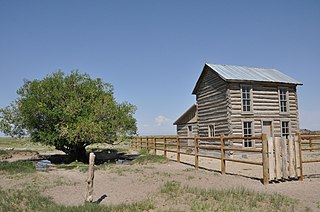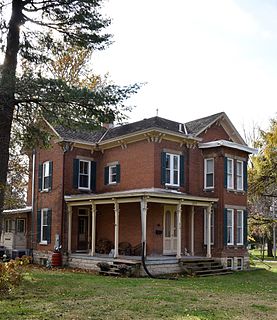
The Richard Nixon Birthplace is the birthplace and early childhood home of Richard Nixon, the 37th president of the United States. It is located on the grounds of the Richard Nixon Presidential Library and Museum at 18001 Yorba Linda Boulevard in Yorba Linda, California, and serves as a historic house museum.

The John Cabot House is a historic house at 117 Cabot Street in downtown Beverly, Massachusetts. Built in 1781 by a prominent local businessman and ship owner, it was the town's first brick mansion house. It is now owned by Historic Beverly and open to the public five days a week. It was listed on the National Register of Historic Places in 1975.

Rancho Petaluma Adobe is a historic ranch house in Sonoma County, California. It was built from adobe bricks in 1836 by order of Mariano Guadalupe Vallejo. It was the largest privately owned adobe structure built in California and is the largest example of the Monterey Colonial style of architecture in the United States. A section of the former ranch has been preserved by the Petaluma Adobe State Historic Park and it is both a California Historic Landmark and a National Historic Landmark. The Rancho Petaluma Adobe State Historic Park is located on Adobe Road on the east side of the present-day town of Petaluma, California.

The Matthew S. Quay House is a historic house at 205 College Avenue in Beaver, Pennsylvania. Built sometime after the American Civil War, it was from 1874 until his death the home of Matthew Stanley Quay (1833-1904), a United States Senator and one of the most influential political party bosses of the late 19th century. His house was declared a National Historic Landmark in 1975. It is now the location of the J.T. Anderson Funeral Home.

Prospect House, known also as just Prospect, is a historic house on the Princeton University campus in Princeton, Mercer County, New Jersey, United States. Built in 1851, it is a fine example of the work of architect John Notman who helped popularize Italianate architecture in America. Notable residents include Woodrow Wilson during his tenure as president of the university. The building now serves as a faculty club. It was designated a National Historic Landmark in 1985 for its architecture and historic associations.

The A. S. Bradford House, also known as The Bradford House, is a historic home in Placentia, California. It was the home of Albert Sumner Bradford, who founded Placentia by arranging for establishment of a water tank along the railway. Homes and businesses within a one-mile radius could get water.

The George Key Ranch Historic District, also known simply as Key Ranch, is a historic ranch and Victorian ranch house located in Placentia, Orange County, California

The Durgin House is a historic house in Reading, Massachusetts. Built in 1872 by Boston businessman William Durgin, this 2+1⁄2-story wood-frame house is one of the finest Italianate houses in the town. It follows a cross-gable plan, with a pair of small side porches and bay windows on the main gable ends. The porches are supported by chamfered posts on pedestals, and feature roof lines with a denticulated cornice and brackets. The main roof line also features paired decorative brackets. There are round-headed windows in the gable ends.

The John Brooks House is an historic house at 12 Nelson Place in Worcester, Massachusetts. Built between 1847 and 1856 by John Brooks, a prominent local farmer and politician, it is one of a small number of 19th-century farmhouses still standing in the city. The house was listed on the National Register of Historic Places in 1980, at which time it was still the hands of Brooks' descendants.

The William Hayden House is a private residence located at 108 West Pottawatamie Street in the city of Tecumseh in northeast Lenawee County, Michigan. It was designated as a Michigan Historic Site and added to the National Register of Historic Places on August 13, 1986.

The North Grove Street Historic District is located along the north end of that street in Tarrytown, New York, United States. It consists of five mid-19th century residences, on both sides of the street, and a carriage barn. In 1979 it was listed on the National Register of Historic Places.

The Meadowbrook Stock Farm, also known as Thomas R. Murray Ranch, is a site on the National Register of Historic Places located near U.S. Route 87 near Hobson, Montana. It was added to the Register on January 13, 1992.

The Trujillo Homesteads are a historic ranch site near Mosca, Alamosa County, Colorado, not far from the Great Sand Dunes National Park. The area was first settled in the 1860s by Teofilo Trujillo, a Mexican sheep farmer. His son Pedro built a log cabin house beginning in 1879, along with other ranch outbuildings and structures. In 1902 the elder Trujillo's home was destroyed by fire during conflicts between English-speaking cattle ranchers and the Spanish Trujillos, who were by then major landowners in the area. The Trujillos sold their holdings, which became part the Medeno Zapata Ranch, now owned by the Nature Conservancy. The homestead area, including the surviving homestead and the ruins of the destroyed one, was declared a National Historic Landmark District in February 2012.

The Beverly Hills Women's Club is an historic house and social club in Beverly Hills, California.

The Arvine and Elizabeth W. White House is a historical residence located in Albia, Iowa, United States. It is the only brick house in town that remains from before the American Civil War. The vernacular-style house has an Adamesque character about it, and it is reminiscent of the style popularized in by Charles Bulfinch and advocated by Asher Benjamin as late as the 1840s. Because White was originally from the Western Reserve of Ohio he was no doubt familiar with the style as it was popular there. The two-story brick house rests on a foundation of native limestone, and it is capped with a hipped roof. It is four bays across the front with the main entrance in the first bay from the left. The house also features a cornice, bracketed eaves, and a 1½-story wing attached to the rear of the main block. It was listed on the National Register of Historic Places in 1994.

The Zephaniah Kidder House is a historic building located in Epworth, Iowa, United States. A Maine native, Kidder settled in Iowa in 1853 after spending time in California. He was one of three men who established the town of Epworth on their land holdings in 1855. Kidder was also instrumental in founding the Epworth Seminary, and was involved in a variety of business ventures. Kidder was involved in the construction of this house, completed in 1868. It is a 2½-story structure built of locally produced brick. The house features a symmetrical plan, side gable roof, bracketed eaves, and two interior brick chimneys. The main facade is three bays wide, with protruding bay windows on the first floor, and the main entrance has sidelights and transom that is covered by a flat-roofed porch. The second floor has windows with keystone drip moldings. The house was listed on the National Register of Historic Places in 1978.

The Clark House is a historic building located in Iowa City, Iowa, United States. This property was originally part of Plum Grove, the estate of Iowa's first Territorial Governor, Robert Lucas. This lot was eventually sold to Florence A. Clark in 1870. She was a granddaughter of Governor Lucas, and her husband, Augustus L. Clark, was a direct descendant of a signer of the Declaration of Independence, Abraham Clark. Built in 1874, the house is a transitional style from the simplicity of Plum Grove to the richness of the Victorian. The 2½-story brick Italianate has an L-shaped main block and a 1½-story wing off the back. The main block is capped with a hip roof with gable ends and bracketed eaves. It also has a wrap-around porch. The house was listed on the National Register of Historic Places in 1996.

The Charles W. and Nellie Perkins House is a historic building located in Cedar Rapids, Iowa, United States. This 2½-story, wood-frame, Queen Anne was designed by local architect Charles A. Dieman. Dieman himself lived in the same middle and upper-class neighborhood. The house was completed in 1897 for Charles Perkins, who had worked as a cashier in a couple of life insurance companies. By 1928 the house had been converted into an eight-plex. Prominent features include the 2½-story corner tower with a conical roof, the large brick chimney on the main facade, the front porch with round-arched brick columns, the hip roof with dormers of various sizes, the bracketed eaves, the Palladian window and bay window on the east elevation, as well as the oval and rectangular window openings. The house was listed on the National Register of Historic Places in 2002.

The Frederick H. and Elizabeth Stafford House was constructed as a private house, located at 4489 Main Street in Port Hope, Michigan. It was listed on the National Register of Historic Places in 1987.

The East Michigan Avenue Historic District is a residential historic district located at 300-321 East Michigan Avenue, 99-103 Maple Street, and 217, 300 and 302 East Henry in Saline, Michigan. It was listed on the National Register of Historic Places in 1985.
























